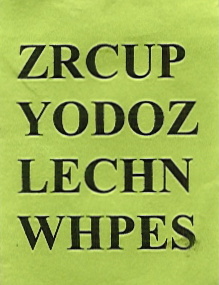This is where the Cryptonomicon Solitaire
encryption algorithm comes in. For more information about how to decrypt
messages using this method, click here: ![]()
For a copy of the SF Chronicle Bridge Column
from Saturday April 21, 2001, click here: ![]()

In order to reverse the encryption of the letters above into the original message, you must know the "key" - the original order of the deck of cards that was used to encrypt the message. You'll remember in our pre-game meeting on Friday evening
(click here for a refresher
![]() ),
),
we were told to create the key for the algorithm by using "...the SF Chronicle Bridge Column from the newspaper on the day you get the message..." All the information you need to arrange the deck into the original order is contained in the links above. {You should mark the two jokers A and B so it's clear which is which.}
Mentally, number the deck from 1 to 53 as follows: A through K of clubs are 1-13, A through K of Diamonds are 14-26, A through K of Hearts are 27-39, A through K of Spades are 40-52, and either joker is considered card 53.
The plaintext message was originally enciphered by doing the following: first, arrange the cards according to the key as indicated in the bridge column (the 'A' Joker goes behind the Ace of Clubs and the 'B' joker goes behind the Ace of Diamonds). You will have 54 cards.
For each letter, go through the seven steps listed below. Step Six of each iteration will yield a single card. Based on the numbering system above, convert this card to a number. Call this number X. Convert the plaintext letter to a number (A=1, B=2, etc). Call this number Y. Then find the number that is mod(X+Y, 26). Convert this to a letter of the alphabet. Repeat for every letter in the plaintext.
To decypt the ciphertext you just reverse the process. Start with the cards in the same order as above, then find each number X, and for every letter Y in the ciphertext, subtract X from Y. If the resulting number is zero or negative, add 26 as many times as it takes to get a number between 1 and 26. Convert this to a letter. Repeat for every letter in the ciphertext until you have the entire plaintext.
There are programs available on the internet which will allow you to input the key (original order of the cards) and ciphertext, and which will then spit out the plaintext. Or, you can solve the code manually. Be warned that the seven steps must be performed perfectly, in succession, for each additional letter. If you drop the cards or mess up in any way, you'll have to start all over from the beginning. Not just step 1, but LETTER ONE!!!
To decipher the code, follow these seven steps for every letter
1. Move the A joker back one card (if it's the 54th card, it will become the 2nd card).
2. Move the B joker back two cards (if it is the 54th card, it will become the 3rd card. If it's the 53rd card, it will become the 2nd card).
3. Swap the cards in front of the top joker with the cards behind the bottom joker. This is called a triple cut.
4. Look at the bottom card. Assign it a number from 1 to 53. Take that number of cards from the top of the deck and put them in front of the bottom card. This is called a count cut.
5. Look at the top card. Assign it a number. Count down that many cards from the top of the deck and look at the card below that number of cards. In other words, if the top card is the 7 of Hearts, it is card 33. You would want to look at the 34th card.
6. Do not alter the order of the deck but write down this card. If it's one of the jokers, don't write it down, go back to step one - this round doesn't count. Convert this card to a number.
7. Convert the ciphertext letter to a number. Subtract the number of the card from step 6 from this number. If zero or less than zero, add 26 until it is between 1 and 26. Convert this number to a letter.
Repeat the above steps for however many letters there are in the ciphertext.
To help you along, the 20 cards you should get are:
QH, 3H, JH, AH, 8H, 10D, 10C, QH, 4H, 8S, KS, KD, 4C, 6C, KC, 5C, AS, 5S, 7C, 8D
And the answer is:
NORTH BERKELEY BART XXX